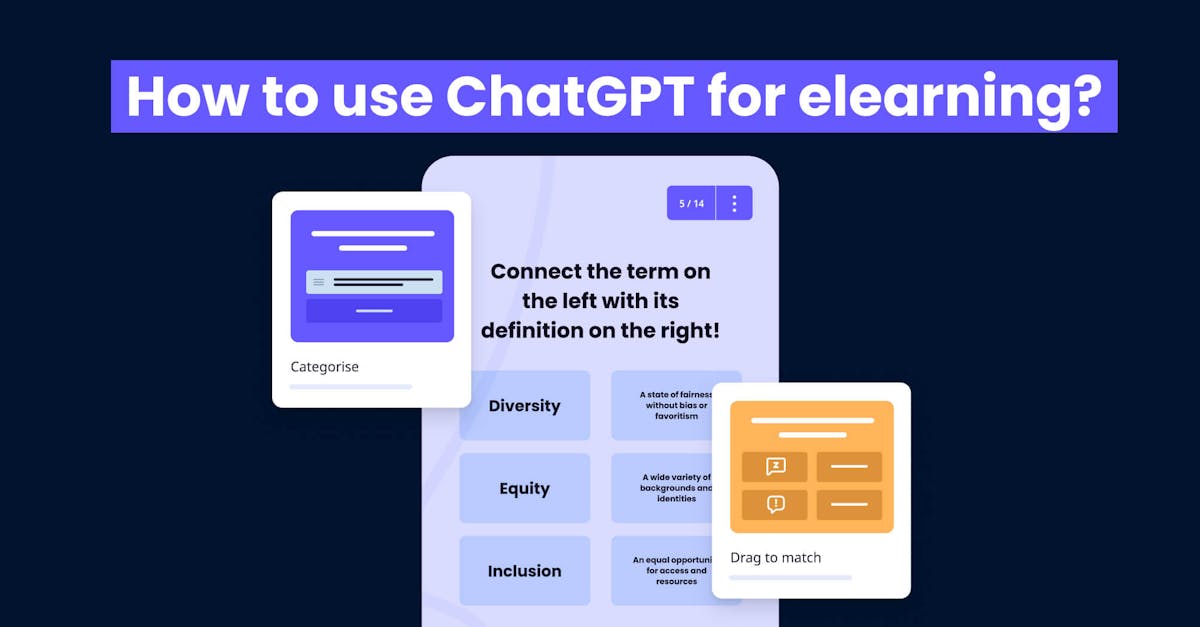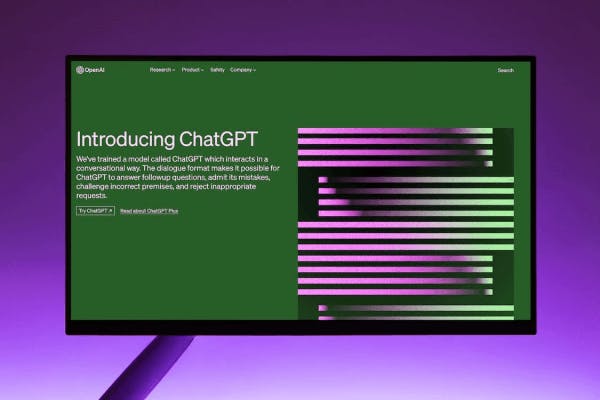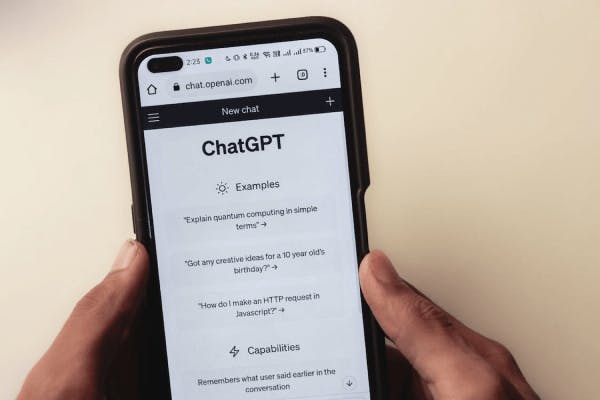How to use ChatGPT for elearning?

As technology continues to advance, new tools and platforms are being developed to enhance the learning experience. One such tool is ChatGPT, a powerful language model that facilitates interactive and personalized learning experiences.
In this article, we’ll explore the concept of ChatGPT for e-learning and discuss how it can be effectively used to enhance the educational journey.
What is ChatGPT?
In today's fast-paced world, e-learning has gained immense popularity due to its flexibility, accessibility, and cost-effectiveness. It allows learners to access training resources and elearning concepts wherever they may be, making learning and upskilling more convenient than ever before.

But, traditional e-learning platforms often lack the interactivity and personalization found in traditional classrooms. This is where ChatGPT comes into play.
ChatGPT, powered by advanced natural language processing algorithms, is designed to engage your trainees in conversational interactions.
ChatGPT uses deep learning techniques to generate human-like responses in a conversational manner. It has been trained on a vast amount of text data and can understand and respond to a wide range of prompts and questions. While many organizations are exploring the potential of ChatGPT for e-learning, partnering with a specialized ChatGPT development company can offer tailored solutions that cater to specific educational needs. As a result, this can give your learners a more immersive and personalized learning experience.
By taking advantage of ChatGPT, both your trainers and teams can create virtual classrooms, interactive lessons, and tutoring sessions that cater to individual needs and learning styles.
How does ChatGPT work?
ChatGPT is built upon a neural network architecture known as the Transformer. This architecture lets ChatGPT process and understand complex language patterns, allowing it to generate coherent and contextually relevant responses. Through large-scale AI pretraining and fine-tuning processes, ChatGPT can generate high-quality responses and learning resources based on the given input.
Benefits of using ChatGPT for e-learning
Learning how to use ChatGPT for e-learning platforms offers several benefits. First, it empowers your trainers to create more engaging and dynamic learning experiences. By integrating it into internal training platforms, your learners can engage in conversations with the model, asking questions, seeking explanations, and receiving instant feedback. This type of approach can contextualize learning better and encourage a more active learning approach.

Lastly, ChatGPT can deliver on-demand assistance and support. Trainees can access the model at any time, even outside their dedicated training hours. They can clarify doubts or seek additional resources that they can use for supplemental training. This gives them the power of self-directed learning and allows them to take control of their learning journey.
How ChatGPT is Used in E-learning Applications
Now that you know what ChatGPT is and the benefits of using it, it’s time to discover how to use ChatGPT for Elearning apps.
Virtual classrooms and tutoring
One of the primary use cases of ChatGPT in e-learning is the creation of virtual classrooms and tutoring sessions. Trainers can set up virtual environments where learners can interact with the model as if they were engaging with a human teacher. This fosters active involvement and knowledge retention by creating a collaborative and engaging learning environment.
Personalized learning experiences
ChatGPT can be used to deliver personalized learning experiences that address your learners' training wants and needs. The AI model adapts the training content and delivery by analyzing learners' answers, progress, and performance.
Based on the learner's competence level and areas for improvement, it can also offer additional explanations, recommend appropriate resources, and give practice exercises. This adaptive learning technique keeps your trainees motivated, engaged, and on pace to meet their learning objectives. Similarly, platforms like UPSkillsTutor are revolutionizing the way we approach personalized education, offering unique opportunities for learners to excel.
Interactive and engaging lessons
Traditional e-learning platforms often lack interactivity and fail to capture teams’ attention. With ChatGPT, educational content can be transformed into interactive and engaging lessons.
Learners can engage in conversational simulations, role-playing activities, and interactive quizzes that make the learning process more enjoyable and immersive.
For example, if you’re training your customer service staff, you can have ChatGPT pretend to be a customer who has a faulty product. The AI can mimic what a customer would say and how they would respond to what your CS staff replies to them. This can give them new and even better ideas for how to tackle difficult customers and give them the solutions they need.
Best Practices for Using ChatGPT in E-learning
Before diving into the world of ChatGPT and its role in elearning, it’s good to consider these best practices when integrating this AI model with your LMS.
Clearly defining learning objectives

Before integrating ChatGPT into an e-learning platform, you need to clearly define the learning objectives you want your learners to achieve. By identifying the desired learning outcomes, you and your trainers can design prompts and activities that align with these objectives. This clarity makes sure ChatGPT exchanges are meaningful and contribute to the learners' training experience.
Structuring conversational interactions

To engage learners effectively, the conversational interactions with ChatGPT should be well-structured. Your trainers can create prompts that encourage them to think critically, analyze information, and apply their knowledge. This better guides them through a logical progression of concepts, reinforcing key ideas, and promoting deep understanding.
Giving feedback and assessment
Feedback plays a crucial role in the learning process. It’s how your learners understand what they can be doing right and wrong and how they can improve from where they currently are. ChatGPT delivers instant feedback to them, acknowledging correct answers and giving explanations for incorrect responses.

This immediate feedback helps learners identify their strengths and weaknesses, helping them to self-correct and improve. Additionally, assessments can be integrated into conversational interactions, allowing trainers to evaluate their progress and adapt their teaching strategies accordingly.
Challenges and Limitations of ChatGPT in E-learning
Of course, as with any new technology, ChatGPT has some shortcomings and limitations as an elearning tool. Here are some that we’ve found:
Lack of emotional intelligence
ChatGPT, being an AI language model, lacks emotional intelligence. It can’t sense learners' emotions, empathize with their struggles, or mimic emotions themselves. Your trainers and managers need to be mindful of this limitation and supplement the conversational interactions with other strategies to address their emotional and motivational needs.

One way you can do this is that while they simulate role-playing situations and conversations in ChatGPT, you can also offer a course on emotional intelligence. This allows them to have a bit more humanity in their interactions with customers, for example, or other members of their team.
Potential biases and inaccuracies
Language models like ChatGPT can inadvertently exhibit biases present in the training data. Additionally, due to the nature of language processing, ChatGPT may generate inaccurate or nonsensical responses. After all, the AI model can’t discern whether something is true or ethically correct.

So while integrating this into LMS, instructors should be vigilant in monitoring the model's responses and securing fairness and inclusivity. Regular monitoring and fine-tuning are necessary to mitigate these issues and maintain the quality of the learning experience. This extra step can also make sure that what your learners are learning about are the most updated strategies, techniques, and skills in the industry.
Overreliance on technology
While ChatGPT can enhance the e-learning experience, it should not replace human interaction entirely. The role of educators in giving guidance, mentorship, and personal connection is irreplaceable. ChatGPT should be seen as a tool to supplement human teaching, rather than a substitute.
How Can EdApp and ChatGPT Be Used Together?
EdApp combined with ChatGPT creates a dynamic and active learning experience unlike any other. If you have EdApp as your LMS, you can explore some of the ways EdApp and ChatGPT can be used together:
- Conversational Learning Experiences: Incorporate ChatGPT within EdApp's course modules to allow learners to engage in conversational interactions. Learners can ask questions, seek clarifications, and receive instant responses from ChatGPT. This fosters active participation and encourages them to delve deeper into the course content.
- AI Course Creation: AI Create converts language prompts or pages of text into interactive microlessons complete with graphics and question slides. The feature is available on the free plan and allows for unlimited use and distribution to users. With AI Create, you can effortlessly generate good idea after good idea without scratching your head.
- Virtual Tutoring and Mentoring: Use ChatGPT as a virtual tutor or mentor within EdApp. Trainees can have one-on-one sessions with the model, receiving personalized guidance and support.
- Interactive Assessments and Feedback: Enhance the assessment process by integrating ChatGPT into EdApp's quizzes and tests. Learners can receive immediate feedback on their answers, explanations for correct and incorrect responses, and suggestions for further study. This real-time feedback helps learners gauge their understanding and promotes continuous learning.
- 24/7 Support and Assistance: Embed ChatGPT as a support feature within EdApp, offering your teams with on-demand assistance at any time. Participants can request assistance with course content, technological concerns, or general questions. Its round-the-clock support enhances learner autonomy and guarantees a seamless learning experience.
- Personalized Learning Paths: Leverage ChatGPT's capabilities to create adaptive and personalized learning paths within EdApp. The model analyzes learners' performance, preferences, and progress, and recommends specific modules or resources tailored to their needs. The customized learning journey promotes self-directed learning and enhances learner engagement.
- Real-Time Language Translation: Use ChatGPT as a language translation tool within EdApp. Learners can input text or audio in one language and receive instant translations or explanations in their desired language. This feature facilitates language learning and cross-cultural communication.
- Natural Language Interfaces: Develop natural language interfaces within EdApp using ChatGPT. Instead of navigating through menus or forms, learners can interact with the platform using voice commands or typed queries. This intuitive interface simplifies the user experience and makes learning more accessible.
EdApp is an AI-integrated learning tool designed for today’s digital habits, delivering more engaging and effective micro-learning directly to learners anytime and anywhere.
Sign up for this AI Create learning tool today.
Author
Stephanie Escuadro
Stephanie is an eLearning content writer for EdApp, a microlearning solution designed for today's digital habits. She creates content about cutting-edge learning technologies and resources to help companies deliver great training experiences. When not absorbed in writing, she spends her time taking care of her dog and binge-watching.
